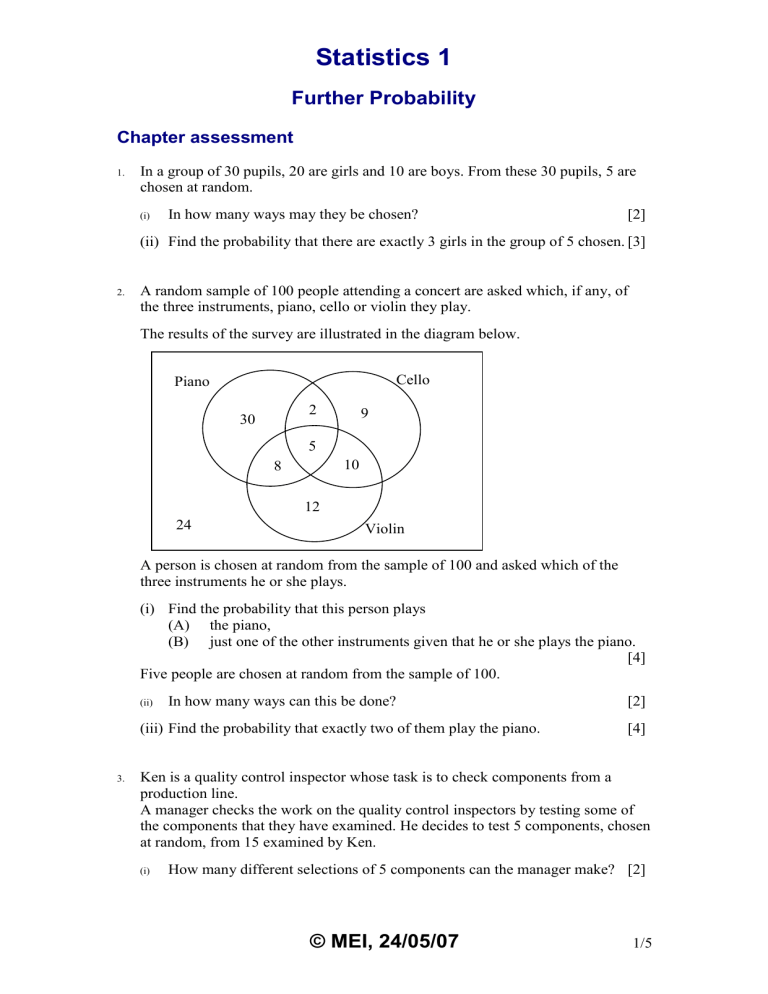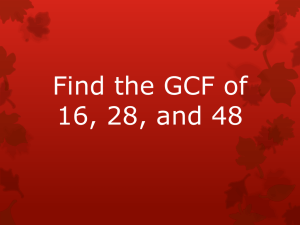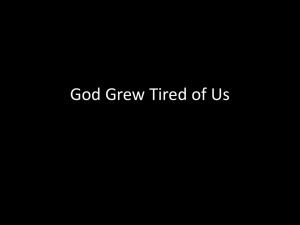Further Probability

Statistics 1
Further Probability
Chapter assessment
1.
In a group of 30 pupils, 20 are girls and 10 are boys. From these 30 pupils, 5 are
2.
chosen at random.
(i)
In how many ways may they be chosen? [2]
(ii) Find the probability that there are exactly 3 girls in the group of 5 chosen. [3]
A random sample of 100 people attending a concert are asked which, if any, of the three instruments, piano, cello or violin they play.
The results of the survey are illustrated in the diagram below.
Piano Cello
30
8
2
5
10
9
3.
12
24
Violin
A person is chosen at random from the sample of 100 and asked which of the three instruments he or she plays.
(i) Find the probability that this person plays
(A) the piano,
(B) just one of the other instruments given that he or she plays the piano.
[4]
Five people are chosen at random from the sample of 100.
(ii)
In how many ways can this be done?
(iii) Find the probability that exactly two of them play the piano.
Ken is a quality control inspector whose task is to check components from a
[2]
[4] production line.
A manager checks the work on the quality control inspectors by testing some of the components that they have examined. He decides to test 5 components, chosen at random, from 15 examined by Ken.
(i)
How many different selections of 5 components can the manager make? [2]
© MEI, 24/05/07
1/5
4.
5.
Statistics 1
(ii) Ken has made mistakes examining 2 of these 15 components. Find the probability that the manager will
(A) test neither of these two components,
(B) test exactly 1 of these two components.
[3]
[3]
Shaldon High School has two AS Mathematics classes, called East and West. East and West each have 15 boys and 5 girls.
The East class chooses 3 students at random to represent it on the MCC
(Mathematics Consultative Committee).
(i)
Find the number of ways in which the 3 students can be chosen. [2]
(ii)
Find the probability that the East class is represented by
(A) three boys, [2]
(B) two boys and one girl. [3]
The West class also chooses 3 students at random to represent it on the MCC, so that the MCC has 6 students altogether.
(iii) Find the probability that the MCC contains
(A) one girl and five boys,
(B) at most one girl.
[3]
[2]
Next September I intend to buy a new car. Its registration plate will be of the form
HW 57 MSD where HW is the local area code for the Isle of Wight, the two digits refer to the year in which the car is registered for the first time, and the last three letters are chosen at random.
The five parts of the question refer to the last three letters of the registration plate.
You may assume that all 26 letters in the alphabet, of which 5 are vowels and 21 are consonants, are used for each of the random choices.
(i)
(ii)
Find the probability that the random letters on the plate are MSD, appearing in that order. [2]
Find the probability that the letters are M, S, D in any order. [2]
(iii)
(iv)
Find the probability that just two of the letters are the same.
Find the probability that just one of the letters is a vowel.
[3]
[4]
(v) Given that just one of the three letters is a vowel, find the probability that the first and last letters are the same. [4]
Total 50 marks
© MEI, 24/05/07
2/5
Statistics 1
Solutions to chapter assessment
1.
(i) 30 C
5
142506
51300
Probability of choosing 3 girls and 2 boys
51300
0.360
(3 s.f.)
142506
2.
(i) (A) Number who play the piano = 30 + 8 + 5 + 2 = 45
Probability
45
0.45
100
(B) There are 45 people who play the piano.
Of these 45, 8 also play the violin only and 2 also play the cello only. So of those who play the piano, there are 10 who play just one of the other instruments.
Probability
10
2
45 9
(ii) Number of ways of choosing 3 girls from 20
Number of ways of choosing 2 boys from 10
20
10
C
C
2
3
Total number of ways of choosing 3 girls and 2 boys
10
1 2 3
1 2
9
45
1140 45
(ii) 100 C
5
100 97 96
75287520
1140
(iii)There are 45 people who play the piano, and 55 people who do not.
Number of ways of choosing 2 people who play the piano
45 44
1 2
990
Number of ways of choosing 3 people who do not play the piano
45
55
C
C
2
5
26235
3.
P(choosing exactly two who play the piano)
75287520
0.345 (3 s.f.)
(i) 15C
5
3003
© MEI, 24/05/07
3/5
Statistics 1
(ii) (A) Number of ways of choosing neither 13 C
5
9
1287
Probability
1287
0.429
(3 s.f.)
3003
(B) Number of ways of choosing 4 from those with no mistakes
13 C
4
715
Number of ways of choosing 1 from those with mistakes = 2
Probability
715 2
0.476
3003
(3 s.f.)
4.
(i) 20 C
3
1140
(ii)(A) Number of ways of choosing 3 boys 15 C
3
Probability (three boys)
455
1140
0.399
(3 s.f.)
(B) Number of ways of choosing 2 boys 15 C
2
105
455
Number of ways of choosing 1 girl = 5
5.
Probability (two boys and one girl) 0.461
(3 s.f.)
1140
(iii)(A) This could be either three boys from East, and two boys and one girl from West, or vice versa.
Probability
455
525
1140 1140
0.368
(3 s.f.)
(B) P(all six are boys)
P(at most one girl)
455
455
1140 1140
455
525
455
455
1140 1140 1140 1140
0.527 (3 s.f.)
(i) Probability
1
1
1
1
26 26 26 17576
(ii) Number of ways of arranging M, S and D = 3! = 6
© MEI, 24/05/07
4/5
Statistics 1
Probability
1
1
1
3
26 26 26 8788
(iii) Number of ways of choosing the letter to appear twice = 26
Number of ways of choosing the other letter = 25
Number of ways of arranging three letters, two of which are the same = 3 so probability
75
17576 676
(iv) Number of ways of arranging one vowel and two consonants = 3
Number of ways of choosing two consonants 21 21 441
Number of ways of choosing one vowel = 5
Probability
6615
17576 17576
0.376
(3 s.f.)
(v) Let A be the event that just one of the three letters is a vowel
Let B be the event that the first and last letters are the same
A B is the event that the first and last letters are the same consonant, and the second letter is a vowel.
P(A B)
21
5
1
105
26 26 26 17576
P(B|A)
P(A B)
105
P(A)
6615
105
1
17576 17576 6615 63
© MEI, 24/05/07
5/5









